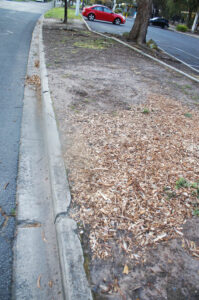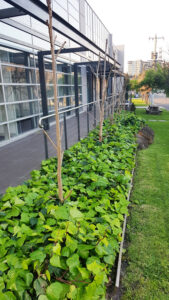Mass planting and groundcover trends – a challenge for industry?
By John Fitzsimmons
In any pursuit, templates can be a valuable aid to consistency and uniformity. The landscape industry is no different. Yet success can become its own worst enemy, especially when formulae become cliches and stifle innovation and creativity, and when cookie-cutter ideas no longer meet current and future challenges. Especially in the commercial and public landscape realm, a lack of diversity is raising challenges to future site outcomes and greenlife industry structure.
There is no shortage of anecdotes about trends in the consumer greenlife market, more intensive living, smaller gardens, the rise of edibles and indoor plants etc. Allied to this has been a great reduction in the numbers of smaller retail nurseries, a rise in online greenlife sales, and a restructuring of the retail landscape generally.
Independent retail nurseries have, understandably and correctly, had to play to their strengths of product knowledge, product quality, personal service and business agility. However, the production and wholesale greenlife sectors have, broadly and generally, responded to change by focusing on smaller numbers of higher volume lines, especially those popular with higher volume ‘roads to market’. That’s understandable too.

In response to changes on the consumer side, many greenlife producers have shifted their balance to the commercial landscape market in both the private and public/corporate sectors. This is also rational and understandable, but the real-world outcomes are starting to reveal some major issues, with many of these revolving around the processes of landscape architecture and design, and project ‘specifications’. By their very nature, many commercial projects, and public projects more so, are the result of ill-informed briefs, conflicting interests of aesthetics, economy, practicality, risk aversion, politics, ego and unintended consequences. Simply, we are seeing too many cliches and too many camels/horses designed by committees.
Recognition and credit should be accorded to those planners and practitioners who work hard to deliver greenlife projects that work now, and continue to provide good returns to their communities into the future. Perhaps the adjudicators of various industry awards could adjust their expectations and create balance in this respect.
However, let’s look at some of the systemic questions arising from this.
The cynical ‘developer’ today focuses on maximising saleable structure on a given site, ignoring the extra value that landscape design and quality greenlife can bring to their project. At an extreme, anecdote has it that many capable and reputable designers are routinely approached by developers offering minimal fees for ‘landscape plans’ that are sufficient to pass planning approval only, to be then discarded for a low-cost cookie-cutter installation of commodity greenlife lines in all too familiar combinations. Exit the qualified and experienced landscaper for the minimally skilled and remunerated labour force.

Historically, the professional landscape designer had exclusive trade access to well-credentialed greenlife growers and wholesalers. However, designers, especially those considerate of greenlife quality and diversity, are increasingly coming face to face with their retail clients as they exit ‘trade outlets’. Propagators, growers and wholesalers are entitled to earn a return for their role in the supply chain – the retail customer is supposed to be at the end of the chain. Admittedly, retail pricing and consumer law is intended to promote competition, however a growing number of designers and landscapers are not feeling confident that their role and recognition in that supply chain is valued.
The situation might be illustrated by the parallel example of the household appliance market. Nearly every retailer sells to the consumer at “25% to 40% off”. Off what? Recommended Retail Price (RRP)? What does that mean now? Obviously, there are no $1000 fridges any more, they are all $600 to $750. What is the price including a reasonable profit, ex-factory? The retailer still wants a profit margin, so the effect is to drive down costs of production (COP), hence more sourcing from low COP countries like China, Vietnam and Turkey.
Certain practicalities prevent that happening to our greenlife market (less so in the Northern Hemisphere) but the downward pressure on production costs is still there. The comment has been made that our greenlife industry is already challenged to attract, reward and retain new people, and that the downward pressure on wages as a production cost is only exacerbating the situation. Current COVID-19 circumstances aside, the Australian greenlife industry has limited opportunities to grow production volumes and/or exports.
It has already been observed that the greenlife choices available to landscape designers are somewhat limited to a defined retail range, and by a formulaic approach to many commercial and public installations. The latter is also influenced greatly by the specifications accompanying many project briefs. The offices that formulate these specifications are not always technically or creatively equipped, and skilled or motivated for that purpose either. Even with good intentions the specified requirements can be problematic.

For example, one major Melbourne metropolitan LGA has reportedly issued a new greenlife project specification for comment. One key requirement is that at least 50% of all new plantings be indigenous species, in 200mm pots! Set aside the continuing debate about Indigenous/Australian species vs exotics, there are already strong concerns that the greenlife industry simply cannot (will not?) meet this requirement in commercial quantities! Some even doubt that appropriate volumes can be supplied in 140mm pots.
The conclusion is there should be far better communication and linkage between the project specifiers and the greenlife industry in terms of what is wanted, what is needed, what is possible, and what is desirable in terms of supply capabilities and horticultural performance

The apparent pre-eminence of economic parameters should also arguably be re-appraised. This foremostly affects the quality, sourcing and appropriate installation of greenlife. It also implies replacement of the word “maintenance” (with its negative connotations of costs to be eliminated or minimised) with the concept of “management”, allied to a continuing need for plant management (pest and disease control, pruning, training and litter management), soil/media husbandry, and replacement/s.
Remember, it has recently been forecast that, as a consequence of climate change, Melbourne’s growing conditions could be closer in just 30 years to those of Dubbo, NSW today! Therefore, more horticultural science and longer-term considerations are needed now.
Mass plantings? Groundcovers?
Whole courses of study and careers are devoted to landscape design, so there is no point in discussing the broad subject here. However, it is worth reminding ourselves of some of the basic reasons for landscaping including aesthetics, passive recreation, shade, wind protection, noise reduction, and soil protection (erosion, compaction). Litter collection or habitat for pests, weeds and diseases are not usually listed as desired outcomes.
In many larger scale projects, mass plantings and groundcovers for soil protection are high priorities. Inorganic materials can be used but ‘living mulch’ usually provides additional solutions to the abovementioned needs. ‘Free mulch’ is usually to be avoided (due to weed and disease risks), in favour of properly composted organic mulch.

So, if greenlife is the preferred groundcover en masse, the next goal should be diversity. The City of Melbourne’s Director, Parks & City Greening, David Callow, has pointed out that urban forests that lack diversity are “vulnerable to pests and diseases, and stress caused by climate change”. He suggests the aim should be “to achieve an urban forest that is composed of no more than:
- 5% of any one tree species
- 10% of any one genus, and
- 20% of any one family”
Even as the City wrote a strategy around these suggested parameters, it also recorded that almost 43% of its trees were from the one family, Myrtaceae. Understandably, new species trials are involving selections from very diverse origins, including South America (e.g. Beilschmiedia miersii), Mexico (e.g. Taxodium mucronatum), Eurasia (e.g. Pterocarya fraxinifolia) and Queensland (Flindersia brayleyana), amongst many others. Ultimately some will ‘work’ and some will not but the case for diversity in treescapes, mass plantings and groundcovers has already been well made.

There is broad recognition of the benefits of indigenous Australian plants already adapted to our climates, especially in view of recent climate volatility and extreme events. However, whether indigenous or ‘exotic’ species are preferred for a project, the key words are ‘climate appropriate’ with a view to changing conditions.
And if the industry cannot, or will not, meet the growing demand for diverse plant lines, at the necessary standards, and in the required volumes, then someone else will fill the vacuum. One scenario has landscapers growing more of their own stock to their own requirements, potentially at the expense of existing industry participants.
Summary
Changing trends at retail, wholesale and production levels in the greenlife industry have both reflected and sustained growth trends in the landscaping sector, especially large commercial and public projects. However, repetition, lack of diversity and innovative design sets the scene for failure to meet emerging challenges and for uncoordinated structural change in the industry.

